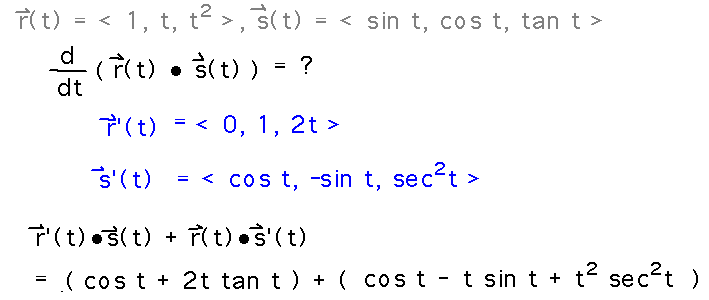Questions?
Derivatives of Vector Valued Functions
Part of section 3.2.
Differentiation Rules
What is the proof that the derivative of a vector valued function is the vector of derivatives of component functions?

Start with the definition of derivative for a vector valued function:

Then expand the vector calculations in that definition:

Now you can move the limit inside the vector...

And finally notice that what you have inside the vector is just the derivatives of the component functions:

Find the 1st derivative of r(t) = 〈 2t2, esin t, √t 〉
How about the 2nd derivative?
Both of these use standard scalar function differentiation rules (e.g., the chain rule, the product rule, etc.) within the component functions:

What’s the 1st derivative of r(t)•s(t) if r(t) = 〈 1, t, t2 〉and s(t) = 〈 sin t, cos t, tan t 〉?
One way to do this is via the product rule for dot products, which is exactly analogous to the one for scalar products:

Another way would be to evaluate the dot product first, and then differentiate it as a scalar:

Applications
What is the formula for the tangent vectors to our snake (s(t) = 〈 t, sin t, (t/6π)51 〉)?
The simple tangent vector function is just the derivative of the snake — much as with scalar functions, the derivative is tangent to the curve traced by a vector valued function.

But this tangent is of who-knows-what length, and you often want a unit tangent vector (e.g., because we want to multiply it by some force to model parts of the snake’s motion). Compute the unit tangent vector by dividing the derivative by its magnitude:

Key Points
The limit definition of a vector valued function’s derivative and the equivalent form as a vector of derivatives.
Using scalar differentiation rules to calculate vector valued function derivatives.
Differentiation rules for vector operations such as dot or cross product.
Problem Set
See handout for details.
Next
Integrals of vector valued functions.
Read “Integrals of Vector-Valued Functions” in section 3.2.